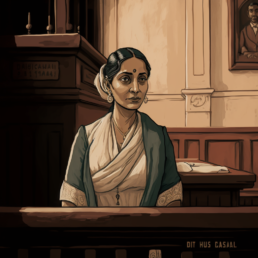You would normally associate a court building with black robes, criminals, police personnel, drama, & extreme emotions. You would not, however, associate it with acting as a lighthouse for ships. The Madras high court has something to say in this regard.
At the beginning of the 19th century, the once small strong-hold of Fort St. George in the southern tip of India had spread out into a massive metropolis serving as the nerve centre for the East India Company’s trading activities in South Asia.
Through Madras, the company’s many schemes and plans spread to the rest of the country. As Madras became an important centre of trade, the movement of ships was an integral part of the business. But, one thing hindering it was the absence of a lighthouse.
According to historians, in 1795 a proposal was presented to the governor in council for a lighthouse, following which a wooden structure with a lighting apparatus was placed on the Exchange Committee building at Fort St. George.
But it didn’t last long; a cyclone in 1807 damaged it heavily. Thereafter, though it was repaired repeatedly, it was evident that the structure was not strong and long-lasting. In 1838, a certain Captain Smith was entrusted with finding a spot for a new lighthouse.
After rigorous scouting and meetings with members of the marine board, a spot was settled upon in Esplanade between the north end of the Fort and Parry’s buildings. A 135-foot-tall fluted granite-stone-covered tower was commissioned in the early 1840s.
This second lighthouse was unsurprisingly the tallest structure in and around Madras. The stones for the Doric column structure were brought from Pallavaram. The lighthouse didn’t function immediately as it took a while to install the light at the top.
The second lighthouse served well. However, in 1888, there were proposals to move the Madras Court complex around the same area. The Madras Supreme Court, as it was then called, had earlier occupied space opposite where the modern-day beach railway station stands.
The plans for a new Indo-Saracenic strcuture were prepared by J. W. Brassington and later on completed by the architect Henry Irwin. Irwin’s imprint can be found all over India including at the Gaiety Theatre & Viceregal Lodge in Shimla and the magnificent Mysore Royal Palace.
Though one can’t be sure whether it was intended, but once the structure was completed, the tallest dome soared through the sky and dwarfed the adjacent lighthouse. It was then decided to make a lantern room on the dome itself, making it the new lighthouse.
But it was not going to be easy, certain readjustments had to be made before it could fully function as a lantern room. The top was cut open to provide access through a spiral staircase. The circular lantern house was made to be 2.5m in diameter, with 2.1m-high murette plates at the bottom.
A 1.2m-high glazed portion consisting of 20 triangular-shaped curved glasses would make a 360-degree view possible. The revolving light emitted by a kerosene lamp was supplied by M/s Chance Brothers, Birmingham, England.
The Chance brothers were pioneers in glass manufacturing in 19th century England. The venue for the Great exhibition in 1851, the Crystal Park was glazed by the Chance Brothers. They also made the opal glass used across the four faces for the Westminster Clock tower, housing the Big Ben.
The lantern room atop the court dome was commissioned on June 1, 1894, and it continued to be in operation until 1977, when the fourth and a modern lighthouse came up on the Marina beach at a height of 148 feet.
In 2017, the second lighthouse standing in the high court complex was renovated and opened to mark the 125th anniversary of the Madras high court. The Madras high court’s once unique functionality is still an intriguing part of the city’s history.
Sources:
GEETA PADMANABHAN, The third lighthouse, https://www.madrasmusings.com/vol-27-no-14/the-third-lighthouse; https://www.dtnext.in/city/2017/09/17/173yearold-renovated-light-house-inaugurated-at-madras-high-court
Cover Image courtesy – Suresh Babunair (Wikimedia Commons)




